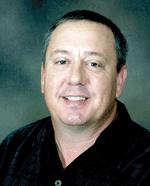Cogon grass (Imperata cylindrica) is an invasive, non-native grass which occurs in Florida and several other southeastern states. A pest in 73 countries, and considered to be one of the “Top 10 Worst Weeds in the World”, cogon grass affects pine productivity and survival, wildlife habitat, recreation, native plants, fire behavior, site management costs and more.
Identifying Cogon Grass
How to Recognize Cogon Grass
Cogon grass is a tall (2-5 ft.) perennial grass with bright yellowy-green foliage. The leaf blades have a mid-vein which is clearly offset to one side, and serrated (toothed) edges. The rhizomes are hard, scaly, and cream-colored with sharply pointed tips. The seed head is fuzzy, white, and plume-like (see images above).
Cogon grass invasion in Central FL upland pine sites
Common Locations for Cogon Grass
Cogon grass is found on roadsides, mining sites, borrow pits, and other areas of soil disturbance, and is able to invade moist to dry upland pine sites, After the initial invasion, cogon grass often forms dense, field-like monocultures.
Cogon grass spreads readily on disturbed sites and through movement of soil contaminated with small pieces of rhizome or seed (often due to site disturbance in timber harvest, site preparation, road grading, use of contaminated fill dirt, etc.). Cogon grass infestations can reduce pine survival and growth, and in fire situations, may result in complete mortality of overstory trees due to flammable oils in the grass blades raising the intensity and severity of prescribed burns. Over time cogon grass may significantly impact management and productivity of pines on infested sites.
Regulatory Status
Due to the damaging effects of cogon grass invasion, cogon grass is listed as a noxious weed by both the state and federal levels. See list of regulations and ordinances at . http://www.fl-dof.com/forest_management/fh_invasives_laws.html
Some Treatment Recommendations
Prevention
Avoid soil disturbance, timber harvest, fire, etc. unless as a part of a specific treatment regime. Always clean equipment after operating in infested areas.
Mechanical/Cultural
Mow or prescribed burn prior to herbicide application to remove built-up thatch and promote active growth herbicide uptake. Do not mow when seedheads are present. Do not burn without a follow-up herbicide treatment.
Chemical
Allow 12 inches of re-sprout before applying
herbicide. Most managers recommend a foliar application of 2% glyphosate (eg. Roundup/Accord), or 1-1.5% imazapyr (eg. Arsenal/Chopper) (be aware of soil activity), or a tank mix of the two herbicides. Apply herbicide by spraying all foliage just until wet to the point of run-off. Links to Identification and Control Guides. (http://www.fl-dof.com/forest_management/fh_invasives_links.html#guides)
Timing
If you can only do one treatment a year, apply your treatment in the fall before the first frost. Otherwise, re-treat regularly whenever adequate foliar re-sprout has occurred.
In Jackson County,
you may contact: Barry Stafford
Jackson County Forester
FL Division of Forestry
850-482-9509
Friday, May 14, 2010
Subscribe to:
Post Comments (Atom)

No comments:
Post a Comment